 Website:
RENISHAW
Website:
RENISHAW
Catalog excerpts
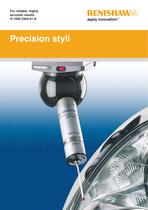
For reliable, highly accurate results H-1000-3304-01-A Precision styli
Open the catalog to page 1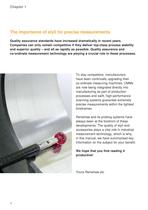
Chapter 1 The importance of styli for precise measurements Quality assurance standards have increased dramatically in recent years. Companies can only remain competitive if they deliver top-class process stability and superior quality – and all as rapidly as possible. Quality assurance and co-ordinate measurement technology are playing a crucial role in these processes. To stay competitive, manufacturers have been continually upgrading their co-ordinate measuring machines. CMMs are now being integrated directly into manufacturing as part of production processes and swift, high-performance...
Open the catalog to page 4
Chapter 1 Renishaw styli provide high-tech precision and superior quality 5
Open the catalog to page 5
Chapter 1 The stylus is the first link between CMM and work piece Z Y 6 X
Open the catalog to page 6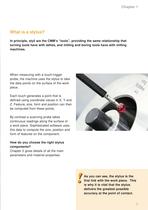
Chapter 1 What is a stylus? In principle, styli are the CMM’s “tools”, providing the same relationship that turning tools have with lathes, and milling and boring tools have with milling machines. When measuring with a touch-trigger probe, the machine uses the stylus to take the data points on the surface of the work piece. Each touch generates a point that is defined using coordinate values in X, Y and Z. Feature, size, form and position can then be computed from these points. By contrast a scanning probe takes continuous readings along the surface of a work piece. Sophisticated software...
Open the catalog to page 7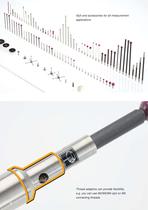
Styli and accessories for all measurement applications Thread adaptors can provide flexibility, e.g. you can use M2/M3/M4 styli on M5 connecting threads 8
Open the catalog to page 8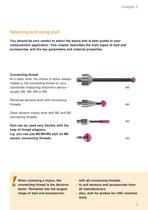
Chapter 2 Selecting and using styli You should be very careful to select the stylus that is best suited to your measurement application. This chapter describes the main types of styli and accessories, and the key parameters and material properties. Connecting thread At a basic level, the choice of stylus always relates to the connecting thread on your coordinate measuring machine’s sensor – usually M2, M3, M4 or M5. Renishaw sensors work with connecting threads. M5 M4 Zeiss sensors mainly work with M5 and M3 connecting threads. M3 Styli can be used very flexibly with the help of thread...
Open the catalog to page 9
Stylus configuration, mounted on an adaptor plate 10
Open the catalog to page 10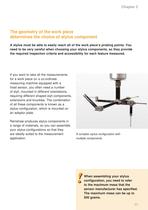
Chapter 2 The geometry of the work piece determines the choice of stylus component A stylus must be able to easily reach all of the work piece’s probing points. You need to be very careful when choosing your stylus components, so they provide the required inspection criteria and accessibility for each feature measured. If you want to take all the measurements for a work piece on a co-ordinate measuring machine equipped with a fixed sensor, you often need a number of styli, mounted in different orientations, requiring different shaped styli components, extensions and knuckles. The...
Open the catalog to page 11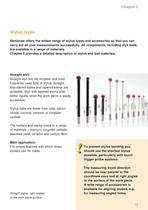
Chapter 2 Stylus types Renishaw offers the widest range of stylus types and accessories so that you can carry out all your measurements successfully. All components, including styli balls, are available in a range of materials. Chapter 3 provides a detailed description of stylus and ball materials. Straight styli Straight styli are the simplest and most frequently used type of stylus. Straight shouldered stems and tapered stems are available. Styli with tapered stems offer better rigidity when the work piece is easily accessible. Stylus balls are made from ruby, silicon nitride, zirconia,...
Open the catalog to page 13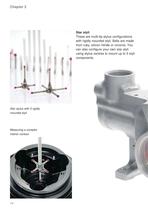
Chapter 2 Star styli These are multi-tip stylus configurations with rigidly mounted styli. Balls are made from ruby, silicon nitride or zirconia. You can also configure your own star styli using stylus centres to mount up to 5 styli components. Star stylus with 5 rigidly mounted styli Measuring a complex interior contour 14
Open the catalog to page 14
Main application: For surfaces and holes with which direct contact can be made. This configuration gives flexibility, enabling the tip to make contact with different features without changing the stylus. Different features can be reached with one stylus configuration 15
Open the catalog to page 15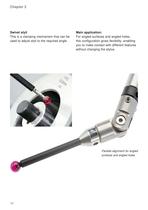
Chapter 2 Swivel styli This is a clamping mechanism that can be used to adjust styli to the required angle. Main application: For angled surfaces and angled holes, this configuration gives flexibility, enabling you to make contact with different features without changing the stylus. Flexible alignment for angled surfaces and angled holes 16
Open the catalog to page 16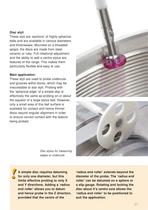
Disc styli These styli are ‘sections’ of highly spherical balls and are available in various diameters and thicknesses. Mounted on a threaded spigot, the discs are made from steel, ceramic or ruby. Full rotational adjustment and the ability to add a centre stylus are features of the range. This makes them particularly flexible and easy to use. Main application: These styli are used to probe undercuts and grooves within bores, which may be inaccessible to star styli. Probing with the ‘spherical edge’ of a simple disc is effectively the same as probing on or about the equator of a large...
Open the catalog to page 17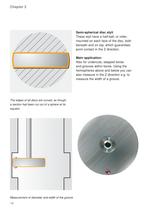
Chapter 2 Semi-spherical disc styli These styli have a half-ball, or roller, mounted on each face of the disc, both beneath and on top, which guarantees point contact in the Z direction. Main application: Also for undercuts, stepped bores and grooves within bores. Using the hemispheres above and below you can also measure in the Z direction e.g. to measure the width of a groove. The edges of all discs are curved, as though a section had been cut out of a sphere at its equator. Measurement of diameter and width of the groove 18
Open the catalog to page 18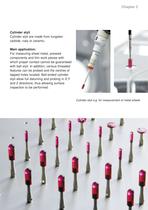
Chapter 2 Cylinder styli Cylinder styli are made from tungsten carbide, ruby or ceramic. Main application: For measuring sheet metal, pressed components and thin work pieces with which proper contact cannot be guaranteed with ball styli. In addition, various threaded features can be probed and the centres of tapped holes located. Ball-ended cylinder styli allow full datuming and probing in X,Y and Z directions, thus allowing surface inspection to be performed. Cylinder styli e.g. for measurement of metal sheets 19
Open the catalog to page 19All RENISHAW catalogs and technical brochures
-
Metrology fixture table
4 Pages
-
Brochure: OMP60
6 Pages
-
OLP40 flyer
6 Pages
-
RFP1 fringe probe for REVO-2
2 Pages
-
RVP vision probe for REVO-2
2 Pages
-
MH20 articulating probe head
2 Pages
-
Data sheet: MH20 and MH20i
4 Pages
-
RTP20
2 Pages
-
PH10M-iQ PLUS
2 Pages
-
REVO-2 and RSP2 probes
2 Pages
-
SFP2 surface finish probe
2 Pages
-
Data sheet: HS20 laser head
2 Pages
-
Data sheet: RLU20 laser unit
2 Pages
-
Data sheet: RLU10 laser unit
2 Pages
-
RLMD01_09
13 Pages
-
RLBD01_04
9 Pages
-
RLCD03_03
9 Pages
-
HiLin™
20 Pages
-
PRIMO™ system
8 Pages
-
TP7M probe and stylus kit
5 Pages
-
RSP3-6 extended reach probe
4 Pages
-
RGH25F UHV, RGH20F UHV
8 Pages
-
RGH22 series readhead
4 Pages
-
Renishaw retrofit
12 Pages
-
Renishaw fixtures
8 Pages
-
SP80
4 Pages
-
SP600
4 Pages
-
Equator the versatile gauge
4 Pages
-
Styli for Zeiss applications
57 Pages
-
CMM technology guide
28 Pages
















































































